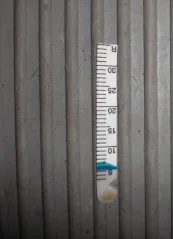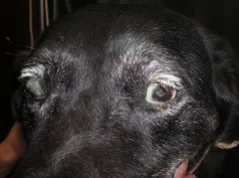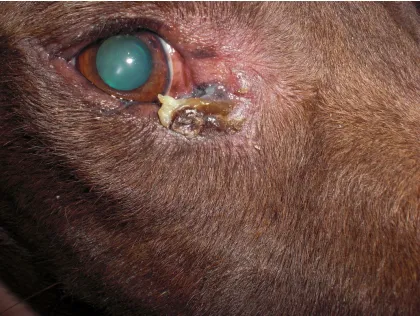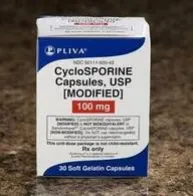This Lab has KCS in both eyes
Keratoconjunctivitis sicca (KCS) or “dry eye” results from lack of water in the tears that nourish the eye. This usually results from an immune disease within the lacrimal glands. It can also result from certain medications like sulfa drugs.
To understand the “dry eye” syndrome, it is necessary to understand the normal health of the cornea as it relates to the tear film. The cornea is the clear, outer windshield of the eye, but like all living tissues it requires oxygen and nutrients. This is not supplied through blood vessels but through the three-layered pre-corneal tear film.
The outer most layer of the tear film is an oily layer supplied by glands in the eyelids. The middle layer is the liquid (aqueous) layer produced by the lacrimal glands that are located in the upper eyelid and in the third eyelid. This is the layer affected in KCS. The inner most layer of the tear film is in direct contact with the cornea and is a mucus layer produced by glands located in the conjunctival membrane.
When the aqueous layer of the tear film is not normal, the cornea becomes dry. Because the water is lost from the tear film, mucus is all that remains and it will accumulate in the eyes. The dried cornea, deprived of oxygen and nutrients through the tear film rapidly undergoes destructive changes resulting corneal ulcers, infections, significant patient discomfort, as well as corneal pigmentation and scarring, which prevents the dog from seeing clearly.
Diagnosis of Dry Eyes
Diagnosis of KCS Diagnosis is based on history, clinical signs and the Schirmer Tear Test (STT) which measures watery tear production.
Schirmer Tear Test. A special filter paper is placed
into the conjunctival sac touching the eye. No tears
are climbing the filter paper in this patient
indicating dry eye.

Schirmer Tear Test. A dye column climbs the filter
paper after 1 minute when there are enough tears.
Anything less than 10mm is abnormal. In this
patient the left eye has plenty of tears and the
right eye is dry
Treatment of KCS
There are several considerations in treating keratoconjunctivitis sicca. A prime consideration is to reduce the overgrowth of bacteria that is common in the dry eye syndrome. The dry eye patient frequently has a buildup of mucus in the eyelids. This mucous is a media for bacterial growth, and antibacterial medications may be warranted.
Some antibacterial medications, whether in an ointment or eyedrop form, will give temporary reduction in the accumulation of secretions because they act as lubricants. However, when they are stopped, the signs of KCS rapidly re-appear.
Artificial tear preparations are often indicated to supplement the deficient tear film. In addition to watery preparations, artificial tear ointments are sometimes used to provide prolonged corneal contact overnight and during times that the patient cannot be treated frequently
The medical treatment for dry eye syndrome is life-long topical medication that stops progression of the disease and to reverse some of the damage already done. New drugs recently developed for the use of treatment of keratoconjunctivitis sicca include immune- modulating agents such as cyclosporine and Tacrolimus. Cyclosporine preparations in ointment or drop form provide both symptomatic relief and may result in the marked increase in tear secretions. One drop is placed in each affected eye twice daily. After 6 months, if the Schirmer tear test shows that the glands are making tears, this can be reduced to once daily treatment. Some dogs with corneal pigmentation will show some corneal clearing after 1 year of treatment.Prognosis




